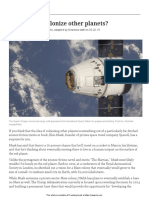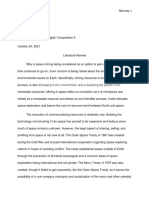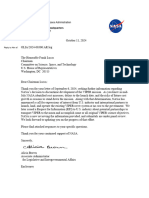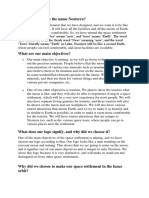Human Migration To Mars
Human Migration To Mars
Uploaded by
watsuyajiCopyright:
Available Formats
Human Migration To Mars
Human Migration To Mars
Uploaded by
watsuyajiOriginal Title
Copyright
Available Formats
Share this document
Did you find this document useful?
Is this content inappropriate?
Copyright:
Available Formats
Human Migration To Mars
Human Migration To Mars
Uploaded by
watsuyajiCopyright:
Available Formats
Human Migration to Mars
What happens when the human population outpaces the resources of our planet? Many
people wonder if moving humankind to another planet is possible. Scientists agree that of all the
other planets in the solar system Mars would be the most habitable but that is not saying much. If
the goal is to create a self-sustaining Martian world, life will be difficult and dangerous.
Mars has similarities to Earth. Its axial tilt is about the same, so Mars experiences similar
seasons. However, its orbital eccentricity is much larger, so the length of the seasons varies, and
a year lasts almost twice as long as on Earth. The desert terrain is similar to some regions on
Earth.
However, despite these similarities Mars is a completely hostile environment. There is no
breathable air and very little air pressure. Lower gravity presents problems for prolonged
settlement. Temperatures vary widely. While they may climb as high as 70º F, in some places
they drop as low as -225º. The soil is toxic and radiation from the Sun is deathly.
All this may seem a little too out of this world but some scientist and a few entrepreneurs
hopes to make the dream of life on Mars a reality. Technology will be a major player in a
successful Mars settlement. Residents will require constant pressurized and heated environments.
Luckily the planet provides a few raw materials such as soil to make concrete. Mars is home to
several large caves, which would screen settlers from radiation. Residents would be able to grow
plants after removing harsh chemicals form the toxic soil. Water on the fourth planet from the
Sun is available but the atmosphere is too thin for liquid water to exist for long. Instead, water
trapped just under the surface of the polar-regions. Extracting water would be vital for drinking,
growing food, and producing oxygen.
Space is opening up the private sector and a few companies toward life on Mars. Elon
Musk, the founder of SpaceX, a space exploration and technology company, aims to build a
colony of 80,000 peoples. SpaceX announced plans to put humans on Mars as early as 2026.
Getting to Mars is not as difficult as landing, surviving on the planet, or even returning to Earth.
Musk told CNBC: “the thing that matters long term is to have a self-sustaining city on Mars to
make life multi-planetary….”
Indicating that Mars could be a refuge in case we outgrow our current planet. Given
Earth’s dwindling resources, that could be sooner than we think.
You might also like
- Reference Module in Earth Systems and Environmental Sciences (2013, 2013, Elsevier)Document11 pagesReference Module in Earth Systems and Environmental Sciences (2013, 2013, Elsevier)fabianNo ratings yet
- Science - Satrun Voyager 1981 PDFDocument30 pagesScience - Satrun Voyager 1981 PDFLuis Romero100% (2)
- A Detailed Lesson Plan in Science 8Document11 pagesA Detailed Lesson Plan in Science 8Isabelo De Asis Alferez100% (2)
- MARSDocument2 pagesMARSJohn Paolo OcampoNo ratings yet
- Designing of Settlement in Space: Made By: Tanu Bhandari Roll No.: 38 Class: X-EDocument15 pagesDesigning of Settlement in Space: Made By: Tanu Bhandari Roll No.: 38 Class: X-Evarunkalra2001100% (1)
- Benchmark-12-Colonize-Planets-52503-Article Quiz and AnswersDocument11 pagesBenchmark-12-Colonize-Planets-52503-Article Quiz and Answersapi-302899266No ratings yet
- Mission Concepts and TimelinesDocument8 pagesMission Concepts and TimelinesGogo PNo ratings yet
- Space - How Far Have We Gone - and Where Are We Going - Science - The GuardianDocument4 pagesSpace - How Far Have We Gone - and Where Are We Going - Science - The GuardianSandra Poliszuk UnizonyNo ratings yet
- Mars Colonization AFFDocument38 pagesMars Colonization AFFJonathan CookNo ratings yet
- MarsDocument6 pagesMarsapi-317599044No ratings yet
- Will The Mars Colonisation Mission Envisioned by Elon Musk Be Successful?Document1 pageWill The Mars Colonisation Mission Envisioned by Elon Musk Be Successful?Yadhu Gopal GNo ratings yet
- Martian Law: U.N. Says World's Population Will Reach 9.8 Billion by 2050. 8-Billion-By-2050Document9 pagesMartian Law: U.N. Says World's Population Will Reach 9.8 Billion by 2050. 8-Billion-By-2050Arif ZamaniNo ratings yet
- The Montreal Convention: Can Passengers Finally Recover For Mental Injuries?Document39 pagesThe Montreal Convention: Can Passengers Finally Recover For Mental Injuries?Chiku ChakerdharNo ratings yet
- Slot Trading: The New Proposal of The European CommissionDocument4 pagesSlot Trading: The New Proposal of The European CommissionGiulia Mauri, Partner - KadrantNo ratings yet
- Elon Musk Announces His Plan To Colonise Mars and Save Humanity.Document2 pagesElon Musk Announces His Plan To Colonise Mars and Save Humanity.Ritwik PrakashNo ratings yet
- USCC China Space Program Report-April 2012Document85 pagesUSCC China Space Program Report-April 2012Jonathan WestonNo ratings yet
- Habitat at MarsDocument28 pagesHabitat at MarsUday DokrasNo ratings yet
- Human SettlementDocument7 pagesHuman SettlementVictor Hugo OrtizNo ratings yet
- ESO Turns 40: CATHERINE CESARSKY, Director General of ESODocument60 pagesESO Turns 40: CATHERINE CESARSKY, Director General of ESOEuropean Southern ObservatoryNo ratings yet
- Moon Colonization Aff UM 7wkDocument64 pagesMoon Colonization Aff UM 7wkiRox132No ratings yet
- NASA Facts Our Planets at A GlanceDocument16 pagesNASA Facts Our Planets at A GlanceBob AndrepontNo ratings yet
- 019 Jan-Feb 1963Document8 pages019 Jan-Feb 1963edicioneshalbraneNo ratings yet
- A Survey of Space ApplicationsDocument138 pagesA Survey of Space ApplicationsBob Andrepont100% (1)
- No. 96 - June 1999Document32 pagesNo. 96 - June 1999European Southern ObservatoryNo ratings yet
- Galatea - Nasa - v3 - FinalDocument50 pagesGalatea - Nasa - v3 - FinalColita YTNo ratings yet
- Latest Developments Around Paranal: The Encounter of Comet Shoemaker-Levy With JupiterDocument68 pagesLatest Developments Around Paranal: The Encounter of Comet Shoemaker-Levy With JupiterEuropean Southern ObservatoryNo ratings yet
- Spacecraft Collision Avoidance Challenge - Design and Results of A Machine Learning CompetitionDocument21 pagesSpacecraft Collision Avoidance Challenge - Design and Results of A Machine Learning CompetitionFrancisco CarvalhoNo ratings yet
- DarwinDocument48 pagesDarwinColita YTNo ratings yet
- Arthur C Clarke - When The Twerms CameDocument2 pagesArthur C Clarke - When The Twerms Camegosai83100% (1)
- NASA Facts Mariner To Mercury, Venus and MarsDocument3 pagesNASA Facts Mariner To Mercury, Venus and MarsBob Andrepont100% (1)
- Mariner Venus Mercury, 1973Document33 pagesMariner Venus Mercury, 1973Bob AndrepontNo ratings yet
- Robotic Lunar Exploration Scenario JAXA PlanDocument26 pagesRobotic Lunar Exploration Scenario JAXA PlanPedro LeonNo ratings yet
- Nasa Eva 2Document87 pagesNasa Eva 2iammad100% (1)
- Shasva OriGInalDocument70 pagesShasva OriGInalharshavardhan reddy75% (8)
- Europa - OrbiterWikiDocument7 pagesEuropa - OrbiterWikiKim NguyenNo ratings yet
- Literature Review Space Mining 3Document7 pagesLiterature Review Space Mining 3api-582787318No ratings yet
- ASTORIA - Apeejay School Sheikh SaraiDocument60 pagesASTORIA - Apeejay School Sheikh SaraiKanishq Baweja100% (1)
- Messenger No30Document32 pagesMessenger No30European Southern ObservatoryNo ratings yet
- Hubble Space Telescope's Top Science FindingsDocument4 pagesHubble Space Telescope's Top Science FindingsMayeth MacedaNo ratings yet
- Priyamvada Bhatt Class IxDocument57 pagesPriyamvada Bhatt Class IxjahanviNo ratings yet
- MangalyaanDocument13 pagesMangalyaanAmeshNo ratings yet
- Current Status of ESC: Speech To The Staff at The ESO Garching Headquarters On December 6, 1994Document56 pagesCurrent Status of ESC: Speech To The Staff at The ESO Garching Headquarters On December 6, 1994European Southern ObservatoryNo ratings yet
- NASA VIPER ResponseDocument19 pagesNASA VIPER ResponseJeff FoustNo ratings yet
- Neoterra (Space Settlement)Document102 pagesNeoterra (Space Settlement)Manoj YeoleNo ratings yet
- Matahari Planet Satelit Semulajadi (Bulan)Document13 pagesMatahari Planet Satelit Semulajadi (Bulan)Anonymous zp6PgvANo ratings yet
- ISS Press KitDocument36 pagesISS Press KitBob AndrepontNo ratings yet
- Geography of MarsDocument14 pagesGeography of Marsmanish.cdmaNo ratings yet
- UAE Space ProgramDocument13 pagesUAE Space ProgramChaitanya RaisinghaniNo ratings yet
- Tridiva (NASA)Document131 pagesTridiva (NASA)Guna SGNo ratings yet
- Voyager 1 Encounter With Saturn Press KitDocument47 pagesVoyager 1 Encounter With Saturn Press KitBob AndrepontNo ratings yet
- MagellanDocument28 pagesMagellanBob AndrepontNo ratings yet
- Lunar Resources: Jump To Navigationjump To SearchDocument10 pagesLunar Resources: Jump To Navigationjump To SearchAryan KhannaNo ratings yet
- ESO/CERN Agreement Renewed: No. 2 - November 1974Document6 pagesESO/CERN Agreement Renewed: No. 2 - November 1974European Southern ObservatoryNo ratings yet
- Successful Completion of An Ambitious Project - A Midwinter Night's DreamDocument40 pagesSuccessful Completion of An Ambitious Project - A Midwinter Night's DreamEuropean Southern ObservatoryNo ratings yet
- Landsat 7 Press KitDocument32 pagesLandsat 7 Press KitBob Andrepont100% (1)
- Origins of NASA NamesDocument242 pagesOrigins of NASA NamesdroberNo ratings yet
- Risks & Rewards: Space TourismDocument19 pagesRisks & Rewards: Space TourismjastybernardNo ratings yet
- NASA Facts Aura A Mission Dedicated To The Health of The Earth's AtmosphereDocument2 pagesNASA Facts Aura A Mission Dedicated To The Health of The Earth's AtmosphereBob AndrepontNo ratings yet
- Some Space MissionDocument14 pagesSome Space MissionHoneylou FarinasNo ratings yet
- Space Vehicles in Action (An Augmented Reality Experience)From EverandSpace Vehicles in Action (An Augmented Reality Experience)No ratings yet
- Space Stations in Action (An Augmented Reality Experience)From EverandSpace Stations in Action (An Augmented Reality Experience)No ratings yet
- Swimming Behavior As An Indicator of Sublethal Toxicity in FishDocument7 pagesSwimming Behavior As An Indicator of Sublethal Toxicity in FishLuciana TalianoNo ratings yet
- London and The Thames Valley - GeologyDocument9 pagesLondon and The Thames Valley - GeologyJosé Luis Rodríguez SánchezNo ratings yet
- For Construction: Doosan Heavy Industries VietnamDocument2 pagesFor Construction: Doosan Heavy Industries VietnamDoan Ngoc DucNo ratings yet
- OGM Lilac TowerDocument28 pagesOGM Lilac TowerDantes Manuel Jr.100% (2)
- 1 Introduce ReDocument2 pages1 Introduce RebellandyNo ratings yet
- Steam Trap TroublesDocument6 pagesSteam Trap TroublesAlexander100% (1)
- QP10-Q-614 Rev0 Typical Drainage DetailsDocument1 pageQP10-Q-614 Rev0 Typical Drainage DetailsnawajhaNo ratings yet
- PlachimandaKerala VAKDocument30 pagesPlachimandaKerala VAKMainakendra Nath MandalNo ratings yet
- P4000A - Thermal Expansion Relief ValveDocument2 pagesP4000A - Thermal Expansion Relief ValveAndy QuynhNo ratings yet
- Agriculture-Wetland Interactions: A Case Study of The Kole Land KeralaDocument109 pagesAgriculture-Wetland Interactions: A Case Study of The Kole Land KeralaYadhu SankarNo ratings yet
- 06 Science WorksheetsDocument34 pages06 Science Worksheetspraveen mbvnNo ratings yet
- Safety Data Sheet NALCO® 8140: Section 1. Product and Company IdentificationDocument9 pagesSafety Data Sheet NALCO® 8140: Section 1. Product and Company IdentificationU.s. Ezhil ArivudainambiNo ratings yet
- Tarnaka Times - Nov& Dec-14Document12 pagesTarnaka Times - Nov& Dec-14nagNo ratings yet
- Quatic Life Forms: Hydrobiology Marine Life Aquatic PlantDocument2 pagesQuatic Life Forms: Hydrobiology Marine Life Aquatic PlantvowNo ratings yet
- Shree Narmada Khand Udyog Sahakari Mandli LTD Ank12 Eia4Document75 pagesShree Narmada Khand Udyog Sahakari Mandli LTD Ank12 Eia4aakash srivastavaNo ratings yet
- Standard Chapter3 PDFDocument33 pagesStandard Chapter3 PDFkarthikkaruppasamyNo ratings yet
- Int Manual EU28Document146 pagesInt Manual EU28baglamaNo ratings yet
- Awash - Water Allocation - Strategic Plan - June - 2017Document58 pagesAwash - Water Allocation - Strategic Plan - June - 2017MeklitNo ratings yet
- Brochure Terram Geosynthetics 2015 GEOCELLDocument44 pagesBrochure Terram Geosynthetics 2015 GEOCELLsonic8981No ratings yet
- ATTCO BrochureDocument40 pagesATTCO BrochurePERICOGARCANo ratings yet
- Fpe 606 Food Plant Layout and Operations 1Document4 pagesFpe 606 Food Plant Layout and Operations 1tsreedathNo ratings yet
- Light Cycle OilDocument4 pagesLight Cycle OilAhmed Qani AlkurdiNo ratings yet
- Self Adhering Sheet Waterproofing Bituthene 3000 and Bituthene Low Temperature GSWP 003A v2Document5 pagesSelf Adhering Sheet Waterproofing Bituthene 3000 and Bituthene Low Temperature GSWP 003A v2200365530No ratings yet
- Fish Kill Investigation Manual: ISBN 0 7245 4705 3 JANUARY 2004Document15 pagesFish Kill Investigation Manual: ISBN 0 7245 4705 3 JANUARY 2004rahmani bagherNo ratings yet
- Al Jafer GROUND FLOOR DRAINAGE SYSTEM (AS&US)Document1 pageAl Jafer GROUND FLOOR DRAINAGE SYSTEM (AS&US)atefNo ratings yet
- Extensive Survey ProjectDocument2 pagesExtensive Survey ProjectSourav Biswas0% (1)
- Bhaskar Save, Gandhi of Natural Farming, EditedDocument12 pagesBhaskar Save, Gandhi of Natural Farming, EditedParth J DaveNo ratings yet
- AWT Trasar Paper FinalDocument12 pagesAWT Trasar Paper FinalsushantNo ratings yet

























































































